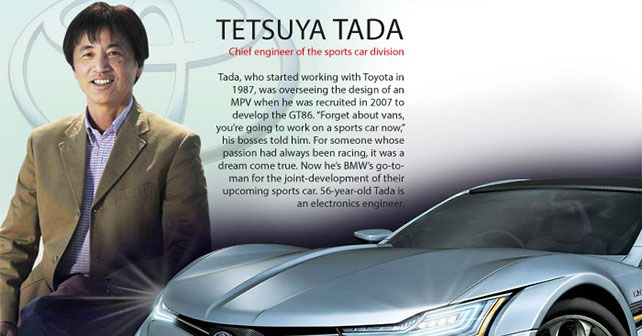
Remember his face, and his name. This Japanese engineer, father of the GT86, is now up for an even more daunting challenge – the car that will breathe life back into the legend of the Supra. This is what he gets up to during his frequent trips to Munich.
By now Tetsuya Tada’s face and passport are well-known to German customs officers. Lately, Tada has been seen transiting from Munich pretty frequently. But he’s not just some Japanese tourist in love with Bavaria – he’s a Toyota engineer on a mission, and on his way to meet his equally determined BMW colleagues.
The object of these super secretive meetings is the joint design of a sports car, which, on the German front, would theoretically replace the Z4, while on the Japanese front it would revive the legend of the Supra – the famous coupe produced between 1978 and 2002. It’s a delicate project for both automakers, but, in a way, the stakes are higher for Toyota.
The Japanese manufacturer puts its strategic long-term plan on the table with the goal of returning to a forgotten emotional idiom that has ended up in a dusty drawer, together with memories of the early 90’s. It’s from those slightly yellowed pictures that President Akio Toyoda intends to draw from in order to develop a line of sports cars that can dismiss the old embarrassing equation: “Toyota = Solid, but Boring Cars.”
The first step in this direction was the fun GT86, designed jointly with Subaru – a project coordinated by Tada himself. Now, the heir of the Supra will be the litmus test for the overall credibility of this plan, which aims to amplify the range of sporty Toyotas not only upwards, but also downwards with an entry-level car a step below the GT86.
According to a source close to Toyota, the project that will create the new Supra “had started even before 2011, when the two automakers announced their collaboration for the supply of turbodiesel BMW engines to the Japanese brand.” But how much of the new car (the concept model will be on display in Tokyo show this fall) will be Toyota, and how much will be BMW? According to voices from Japan, the mechanical foundations will be drawn from the same platform as the GT86, but carefully inspected by the men in Munich.
But Tada himself, interviewed on the issue by Quattroruote, has resolutely excluded this eventuality. “From the GT86, in addition to the convertible, we will extract a compact sports sedan, which means the fullest possible extension for that platform.” Pending the uncovering of the mystery, we can state fairly confidently that the engine powering it will be German, and that the car will incorporate a hybrid system.
In fact, due to the fact that it’s scheduled for 2016-2017, it won’t have any other recourse but to seek the help of an electric motor to meet the average limit of 95 g/km CO2 emissions established by the European Union for 2020. And this is where Toyota’s know-how comes into play, as it’s already at work on the next generation of its Hybrid Synergy Drive. The system will be coupled with a brand-new dual-clutch transmission. In order to employ the new transmission on as many engines as possible, the engineers of Toyota City have conceived the gearbox in a way that makes it adaptable to both transverse and longitudinal engines. Our sources also maintain that Toyota is secretly testing a GT86 with electric motors mounted inside the wheels, and that this electrically-assisted all-wheel drive framework might be the principal variant of the sports car. We’ll see if the concept that will be shown in Tokyo will give us any more answers.
All the steps needed to revive two automotive classics
It all officially began with a preliminary deal announced at the Tokyo Show in December 2011. This handshake between the heads of the two companies in front the worldwide press made the technical alliance between BMW and Toyota clear for everyone to see. Halfway through 2012, the deal was extended. Together with joint research on the future of batteries and the supply of BMW turbodiesel engines to the Japanese, further cooperation was agreed on in the development of lightweight materials, fuel cell technology, and “the architecture and components of a sports car.” On the Toyota front, however, there is a plan that was confirmed by Tada himself – a sports car below the GT86, along with a more powerful and expensive model above it. The latter, over the span of the next three years, would ideally substitute the Supra (above left) – now out of production. The BMW, on the other hand, has the new Z4 in the pipeline (above right) scheduled for 2016. Coincidence?
© Riproduzione riservata



















Write your Comment